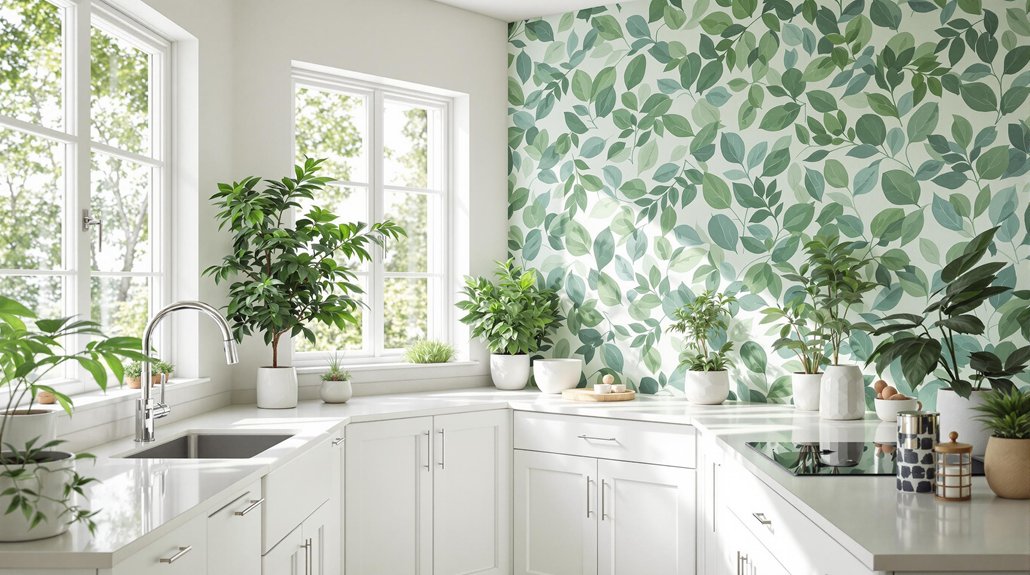
15 White Kitchen With Green Wall Ideas That Are Calm and Nature-Inspired
White kitchens with green walls evoke calm and nature-inspired design by integrating soft sage or mint tones, layered green accents, and luminous white cabinetry. Olive or deeper greens add grounding and visual interest, while brass or wood accents introduce warmth and textural depth. Marble surfaces and green tile backsplashes maximize light and color vibrancy. Botanical elements or pastel pink or yellow décor enrich harmony. This versatile approach creates tranquil yet visually engaging spaces—explore further for curated inspiration and expert strategies.
Key Takeaways
- Soft sage or mint green walls create a tranquil, nature-inspired backdrop that complements the crispness of white kitchen cabinetry.
- Layering multiple green tones, such as pairing sage walls with deeper green accents, adds depth and visual interest to the space.
- White cabinets paired with olive green accents or islands balance brightness with a grounded, organic feel reminiscent of the outdoors.
- Incorporate natural materials like wood and potted plants to reinforce the calming, biophilic design and add cozy farmhouse warmth.
- Green tile backsplashes with varying shades and finishes enhance the serene atmosphere and provide easy-to-maintain decorative interest.
Soft Sage Walls for a Tranquil Kitchen Retreat
Soft sage green walls establish a tranquil foundation in kitchen design, promoting a sense of calm and subtle connection to nature. This soft green paint infuses the space with a muted, earth-inspired hue that seamlessly complements white cabinetry, enhancing visual brightness while preserving a sophisticated, balanced palette.
The choice of green walls is rooted in biophilic design principles, drawing from the restorative qualities of the outdoors to foster a calming atmosphere. Such nature-inspired elements transform the kitchen into a restful retreat, ideal for gathering and unwinding.
The understated tone of sage green guarantees versatility, harmonizing with both modern and farmhouse aesthetics. Integrating these hues with natural materials, like wood accents or potted plants, further reinforces the kitchen retreat’s serene and inviting ambiance.
When selecting design elements, opting for eco-friendly materials can enhance the sustainable and harmonious vibe of the kitchen, aligning with principles that promote environmental consciousness and well-being.
Layering Green Tones for Depth and Visual Interest
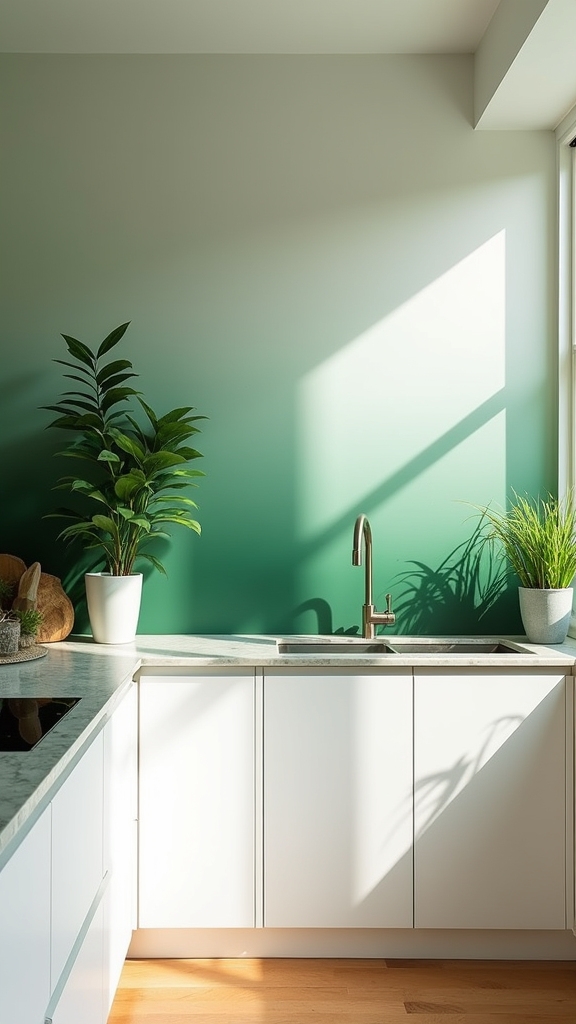
Expanding beyond a singular green hue on the walls, layering multiple shades of green introduces dimensionality and sophistication to a white kitchen.
Implementing green tones—such as pairing soft sage with deeper forest green cabinetry—cultivates depth and visual interest while preserving a cohesive, nature-inspired palette. This design strategy avoids a flat, blocky appearance by adding complexity and movement.
Lighter greens infuse the space with freshness and airiness, while darker tones provide grounding and contrast against crisp white surfaces. The intentional layering of green tones visually delineates distinct kitchen zones, enhancing organization without sacrificing harmony.
Integrating organic materials, like wood, alongside varied greens further reinforces the nature-inspired concept, yielding a white kitchen that feels both structured and inviting through nuanced color interplay.
Pairing White Cabinets With Olive Green Accents
When integrated deliberately, olive green accents introduce a grounded, organic quality to kitchens dominated by crisp white cabinetry. This color pairing leverages contrast and harmony, where the brightness of white cabinets is balanced by the subdued richness of olive green.
The result is a nature-inspired aesthetic that feels both fresh and inviting. Olive green’s calming properties foster a serene atmosphere, which is particularly desirable in high-traffic kitchen environments.
A nature-inspired olive green palette infuses kitchens with freshness and serenity, creating a calming retreat in bustling home spaces.
In contemporary kitchens, olive green can be strategically applied through feature walls, tiled backsplashes, or select decorative accessories, reinforcing a modern yet approachable visual language.
The interplay between white and olive green guarantees depth without visual clutter, creating a cohesive environment that emphasizes clarity and comfort. Such combinations offer timeless appeal and enduring design versatility.
Cozy Farmhouse Kitchens With Green and Wood
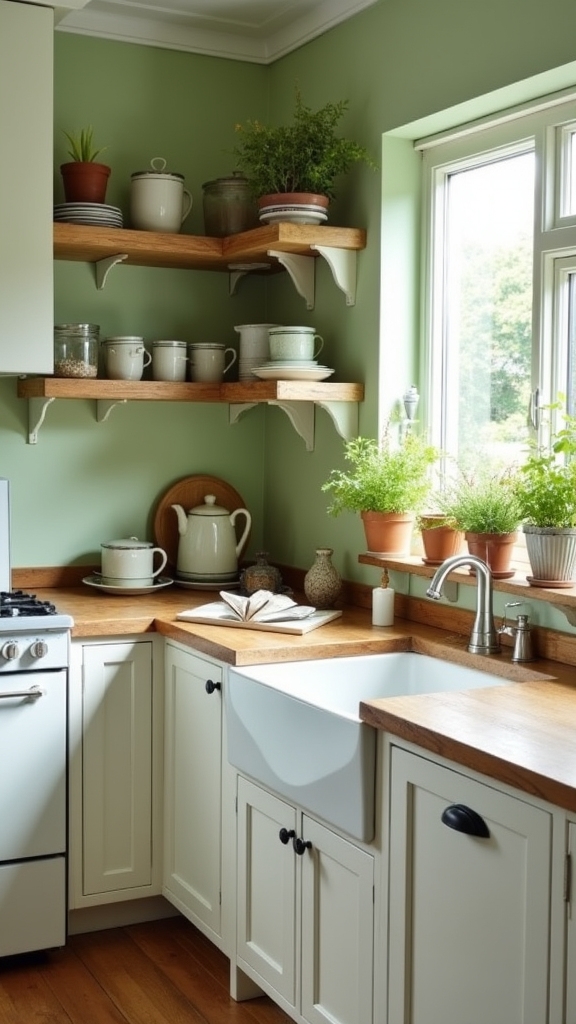
Building upon the interplay of white cabinetry and olive green accents, farmhouse kitchens achieve a distinctive warmth through the integration of gentle green wall tones and authentic wood elements. In cozy farmhouse kitchens, the convergence of green walls and natural wood elements establishes a calming effect that is both visually pleasing and functionally inviting. White cabinetry amplifies brightness, balancing the earthy palette while preserving the inviting atmosphere emblematic of farmhouse design. Textural variation—exposed beams, wooden shelves, and mixed finishes—articulates a layered sense of comfort and rustic sophistication. Strategic placement of greenery and curated decor strengthens the connection to nature, reinforcing tranquility.
| Design Element | Visual Impact |
|---|---|
| Green walls | Calming effect, subtle color depth |
| Natural wood elements | Warmth, organic texture |
| White cabinetry | Bright, inviting atmosphere |
Fresh Mint Green Walls for an Airy Feel
A subtle infusion of fresh mint green on kitchen walls introduces a sense of lightness and spatial expansion, enhancing natural illumination and fostering visual continuity.
This nature-inspired hue seamlessly pairs with white cabinetry, reinforcing an airy atmosphere that promotes calm and relaxation. The tranquil cooking environment created by mint green walls is both visually invigorating and psychologically uplifting.
Designers value this color’s versatility, as it complements a spectrum of kitchen aesthetics. For ideal results, consider these professional strategies:
Mint green’s versatility enhances a wide range of kitchen styles—professional tips ensure it elevates both aesthetics and ambiance.
- Apply fresh mint green on all walls for a cohesive, expansive feel.
- Use as an accent wall to highlight architectural features and white cabinetry.
- Coordinate with minimalistic fixtures to emphasize the airy atmosphere.
- Incorporate natural textures for enhanced calm and relaxation, strengthening the nature-inspired theme.
Dramatic Dark Green for a Moody Statement

While mint green delivers airy serenity, deep green walls introduce a bold dimension to white kitchens, commanding visual attention and architectural focus.
A dramatic dark green, such as bottle green or forest green, establishes a contrasting canvas that highlights the crispness of white cabinetry and accents. This color strategy imparts a sophisticated and elegant ambiance, with the depth of dark green evoking a cozy, inviting atmosphere ideal for gatherings.
The interplay between dark green walls and brightening elements—like white subway tiles or quartz countertops—creates visual balance and enhances the spatial experience. Incorporating polished gold or brass hardware further enhances the kitchen’s elegance, introducing subtle glamour.
Mixing different grey shades adds depth and visual interest, enhancing overall design. Ultimately, dark green walls transform a white kitchen into a refined, moody statement space characterized by warmth and design distinction.
Bringing Nature Indoors With Botanical Wallpaper
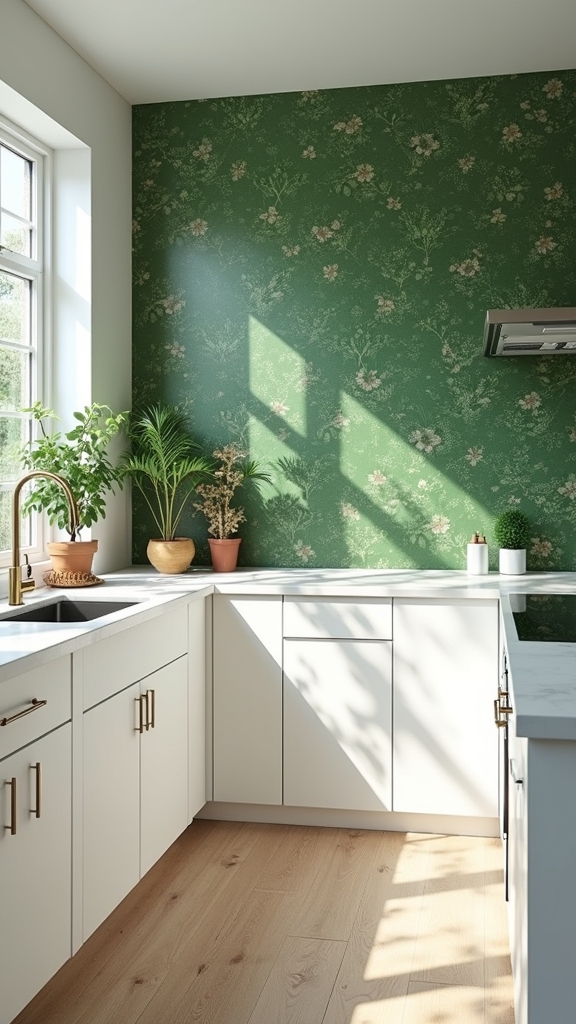
Infusing a white kitchen with botanical wallpaper introduces dynamic visual interest, utilizing organic patterns to blur the boundary between interior space and the natural world.
By selecting designs that feature lush leaves, delicate florals, or tropical motifs, homeowners can reinforce the calming effects of green walls, cultivating a tranquil kitchen design.
Botanical wallpaper not only enhances the visual cohesion of a nature-inspired palette but also supports an indoor-outdoor feel, especially when layered with wood accents and living greenery.
For maximum effect and functionality, consider the following:
- Opt for washable botanical wallpaper to withstand kitchen splashes.
- Pair wallpaper with green walls to amplify nature-inspired continuity.
- Integrate wooden shelving for organic warmth and texture.
- Accent with potted plants to reinforce the indoor-outdoor ambiance.
Two-Tone Green and White Kitchen Cabinets
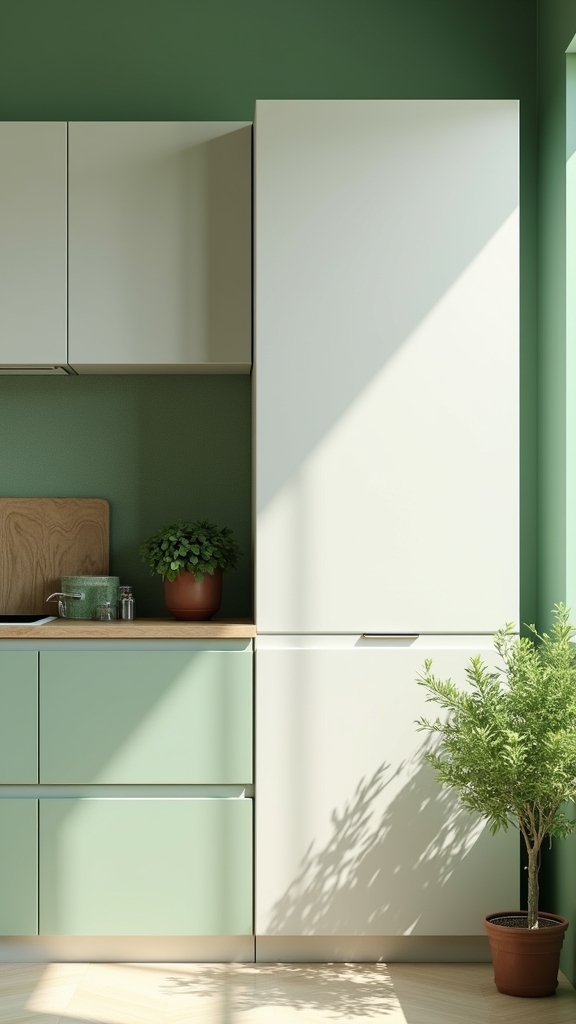
Building upon the organic importance introduced by botanical wallpaper, two-tone green and white kitchen cabinets establish a striking visual framework that balances freshness with sophistication. This palette, where green adds an earthy vibrance to lower storage and white cabinetry enhances upper openness, exemplifies a nature-inspired theme. The calming effect of soft green tones—such as sage or mint—integrates seamlessly with crisp white, delivering a modern farmhouse aesthetic. Functionally, two-tone green and white kitchen cabinets can delineate cooking and prep zones, while wood accents infuse warmth. This design approach is both visually dynamic and harmonious, reflecting a growing affinity for nature-inspired colors and elements. Greige cabinets are known for their ability to seamlessly blend with various design styles, ensuring timeless appeal.
Accenting With Green Kitchen Islands
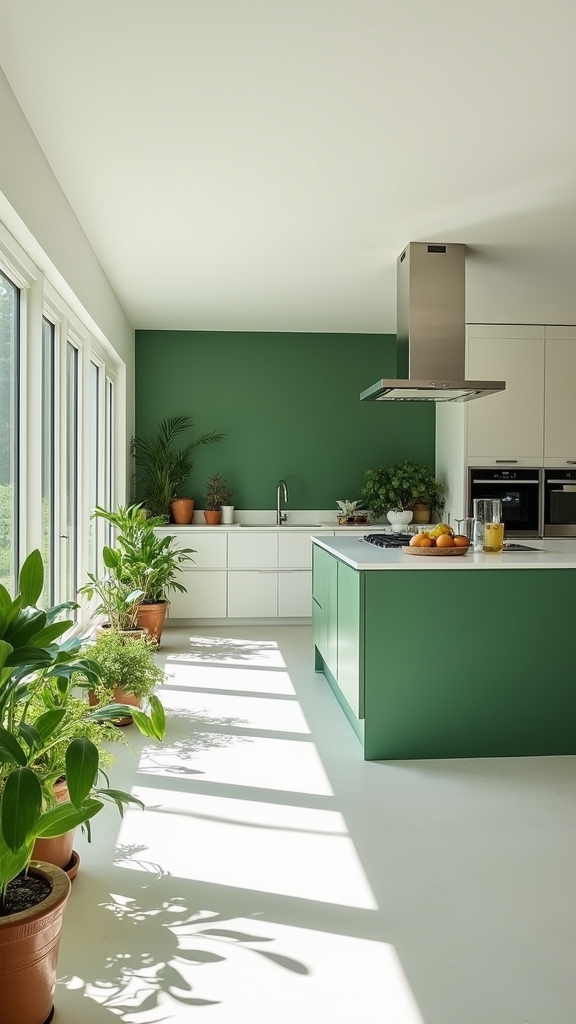
Anchoring the kitchen’s design, a green island introduces a deliberate focal point that disrupts the uniformity of white cabinetry with vibrant contrast.
Green kitchen islands, especially in nuanced tones like sage or olive, reinforce a calming atmosphere, reminiscent of the outdoors. Their visual interest is further heightened when paired with accent features and natural materials.
Employing a two-tone design approach, a green island not only delineates work zones but also enhances spatial organization.
- Green kitchen islands provide dynamic color contrast, elevating the kitchen’s aesthetic.
- Integrating natural materials, such as wooden countertops, softens the bold hue and invokes warmth.
- Accent features—like brass hardware—add sophisticated detailing and support the nature-inspired scheme.
- The interplay between green islands and white cabinetry defines functional areas, ensuring clarity and cohesion.
- Adding textured accents, such as exposed brick or wood paneling, enhances visual depth and warmth, complementing the calming essence of the green island.
Subtle Pops of Green With Accessories and Plants
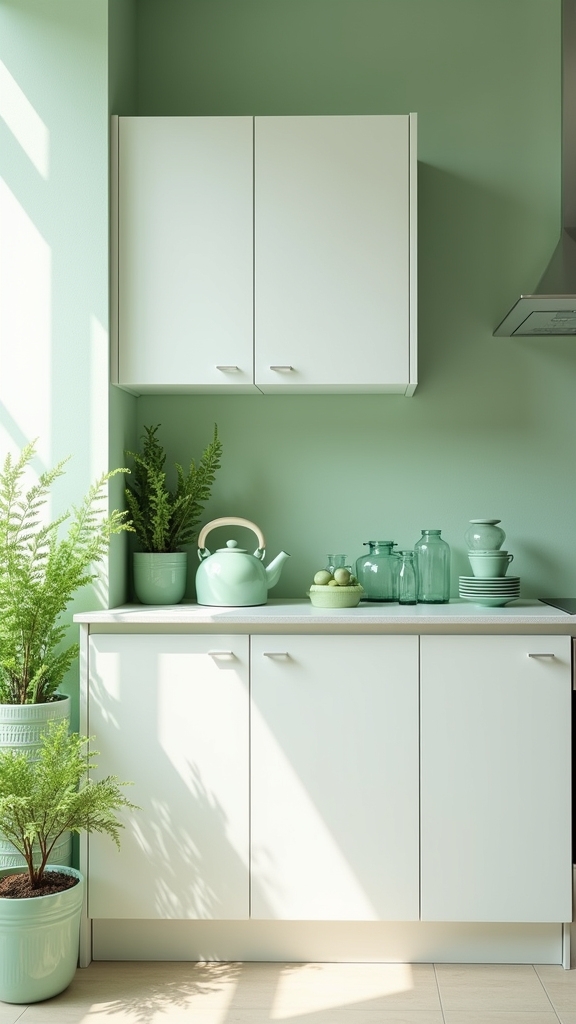
While green kitchen islands offer bold statements within a white kitchen, subtler applications of green through accessories and plants create a nuanced, layered effect. Designers recommend incorporating potted plants—herbs or succulents—for natural vibrancy and textural contrast. Green kitchen accessories, such as utensil holders or dish towels, deliver harmonious accents that reinforce the palette. Botanical-themed artwork or wall decals introduce biophilic design, supporting a serene inviting kitchen environment. Green glassware and tableware function as sophisticated focal points, enhancing both form and function. Layering textures with green fabric elements, like cushions or curtains, further enriches the tactile experience and visual depth. This strategic approach achieves balance, ensuring the green elements unify rather than overwhelm.
| Green Element | Design Contribution |
|---|---|
| Potted Plants | Organic vibrancy, texture |
| Botanical-Themed Artwork | Cohesion, nature-inspired ambiance |
| Green Glassware | Elegant accent, color unity |
| Layered Textiles | Tactile richness, serene atmosphere |
Modern U-Shaped Kitchens With Evergreen Fog
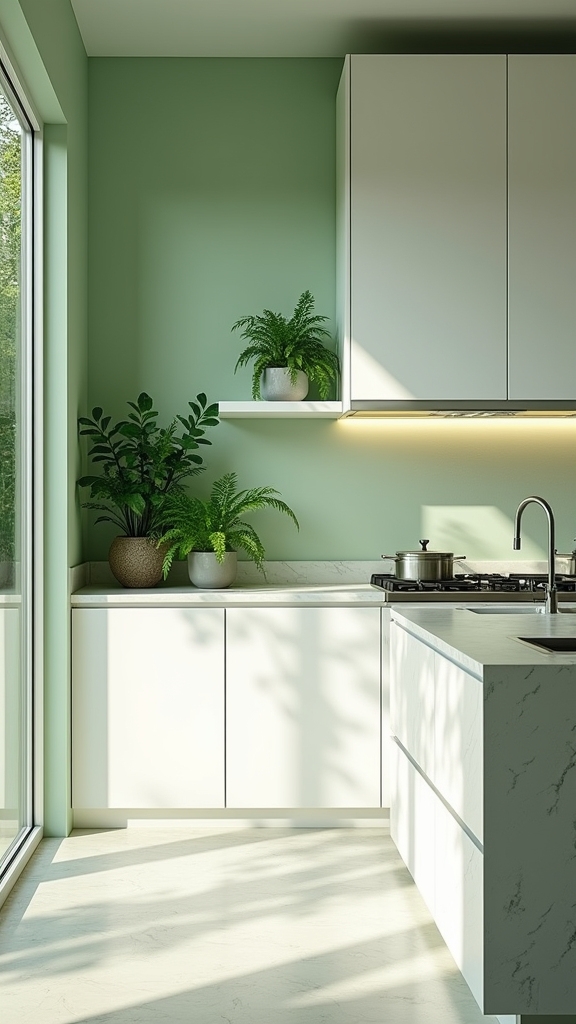
Subtle yet sophisticated, modern U-shaped kitchens achieve enhanced harmony by pairing soft green hues like Evergreen Fog with crisp white cabinetry.
This thoughtful combination not only enhances visual spaciousness but also establishes a calming environment, ideal for both culinary tasks and social gatherings. Evergreen Fog serves as a gentle backdrop, differentiating functional zones without overwhelming the senses.
Integrating natural materials and organic touches further uplifts the design’s warmth and texture. Incorporating elements such as reclaimed wood and natural stone can add authenticity and tactile richness to the kitchen, enhancing its rustic charm.
Key design strategies include:
- Utilize Evergreen Fog on feature walls to create visual depth and distinct kitchen zones.
- Pair white cabinetry and countertops for a luminous, open aesthetic.
- Incorporate wood or stone accents to add tactile warmth with natural materials.
- Introduce plants or green decor to reinforce organic touches, promoting a serene, nature-inspired atmosphere.
Mixing Marble, Brass, and Green for Elegant Touches
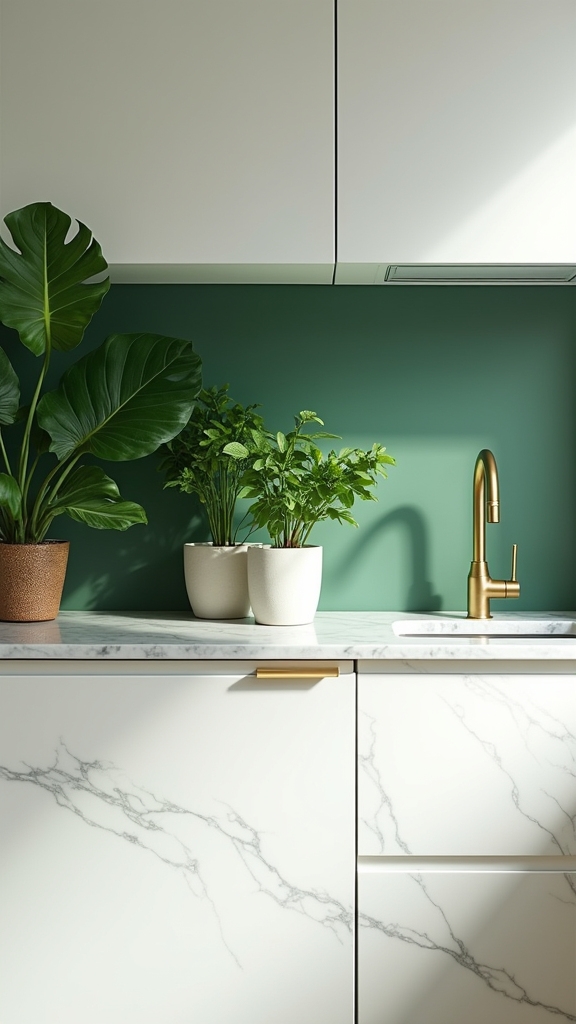
Pairing green cabinetry with white marble surfaces establishes a refined contrast that maximizes both light reflection and color vibrancy in the kitchen.
Accentuating this palette with brass hardware and fixtures introduces a layer of visual warmth, balancing the coolness of marble and green.
The thoughtful integration of these elements exemplifies a harmonious approach to material juxtaposition and cohesive design.
Pairing Green With Marble
A harmonious blend of soft sage green walls and pristine white marble countertops establishes a refined visual balance in the kitchen, accentuating both tranquility and sophistication.
This distinctive pairing leverages professional design principles to enhance a calming atmosphere while maintaining visual interest. The organic feel of green walls juxtaposed with the cool, seamless surface of white marble improves the kitchen design, creating a serene yet elegant setting.
- Green walls introduce a soothing backdrop that complements the subtle veining of white marble, reinforcing a natural, organic feel.
- White marble countertops and backsplashes reflect light, amplifying the sense of spaciousness and calm.
- Decorative elements, such as marble trays or green-tinted pottery, unify the color palette for visual cohesion.
- Cohesive integration of materials fosters a sophisticated and timeless ambiance.
Accenting With Brass Details
Incorporating brass accents introduces a distinctive layer of visual depth to kitchens featuring green walls and white marble surfaces. Brass details—ranging from cabinet handles to lighting fixtures—offer warmth and richness, elevating the elegance of kitchen design. The interplay between marble countertops, nature-inspired green walls, and brass accents achieves a sophisticated, harmonious ambiance. By strategically placing brass shelf brackets or decorative accents, designers guarantee cohesion, avoiding visual clutter while amplifying refinement. Brass’s warm undertones complement both deep emerald and muted sage greens, balancing the coolness of green with inviting metallic luster. This approach results in a timeless aesthetic, blending natural stone beauty and refined metal finishes.
| Brass Element | Placement | Design Impact |
|---|---|---|
| Cabinet Handles | Cabinetry | Elegant Contrast |
| Light Fixtures | Ceiling/Wall Mount | Layered Warmth |
| Shelf Brackets | Open Shelving | Cohesive Detail |
Green Tile Backsplashes for Colorful Flair
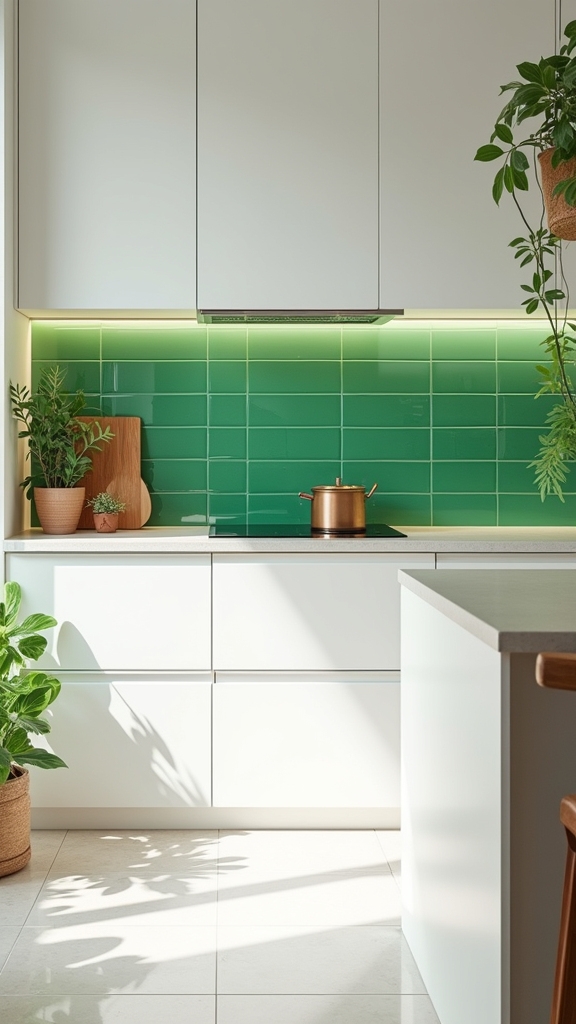
Selecting the appropriate shade of green tile is vital for achieving a harmonious balance with white cabinetry, whether opting for subtle sage or a bold emerald hue.
Strategic pairing of tile finishes and patterns with cabinet styles enhances cohesion and accentuates visual contrast within the kitchen.
Additionally, understanding material durability and maintenance requirements guarantees that the backsplash retains its aesthetic appeal and functionality over time.
Choosing Green Tile Shades
While designing a white kitchen, introducing green tile backsplashes offers an opportunity to infuse the space with color and visual interest.
Selecting the appropriate green tile shades is integral for achieving a cohesive design that harmonizes with white cabinetry and enhances the backsplash area.
Design professionals recommend evaluating the following elements:
- Shade Variation: Assess whether soft pastel or deep, saturated green hues align best with the desired kitchen ambiance.
- Finish Selection: Choose between glossy green tiles for a contemporary, light-reflective surface or matte finishes to evoke a rustic, organic feel.
- Pattern Integration: Employ patterned green tiles to add visual interest and uplift the backsplash area with dynamic, sophisticated detailing.
- Material Coordination: Consider how green tiles interact with countertops and hardware to maintain a cohesive design language throughout the space.
Pairing Tiles With Cabinets
Although white cabinetry provides a crisp foundation in kitchen design, pairing it with green tile backsplashes introduces dynamic color contrast and enhances visual interest.
Green tiles, particularly in shades such as sage or emerald, infuse the space with a calming atmosphere while offering a striking juxtaposition against the neutral backdrop of white cabinetry.
Utilizing glossy green subway tiles alongside matte finish cabinets creates deliberate texture contrast, adding depth to the overall aesthetic.
For added personality, patterned green tiles serve as a backsplash, injecting playful energy while maintaining a cohesive look.
Selecting tile size and shape in harmony with the kitchen’s layout further refines the visual flow.
Ultimately, integrating green tiles with white cabinetry boosts both color dynamics and tactile appeal in a nature-inspired kitchen.
Maintenance Tips for Backsplashes
Elevating the kitchen’s visual impact, green tile backsplashes demand thoughtful maintenance to preserve their vibrant hue and crisp appeal amid daily use.
Professional upkeep not only safeguards the integrity of these calming, nature-inspired elements but also guarantees their colorful flair remains a focal point in a white kitchen.
Adhering to these maintenance principles is essential:
- Clean green tile backsplashes regularly with a mild detergent and water solution to maintain vibrancy and prevent residue buildup.
- Seal grout lines post-installation to mitigate grout discoloration and protect against moisture intrusion.
- Use a soft cloth for daily wipe-downs, removing grease and food splatters for a fresh, polished finish.
- Opt for non-abrasive cleaners or a diluted vinegar solution to address stubborn stains without compromising tile surfaces.
This systematic approach preserves both beauty and function.
Playful Pairings: Green Walls With Pink or Yellow
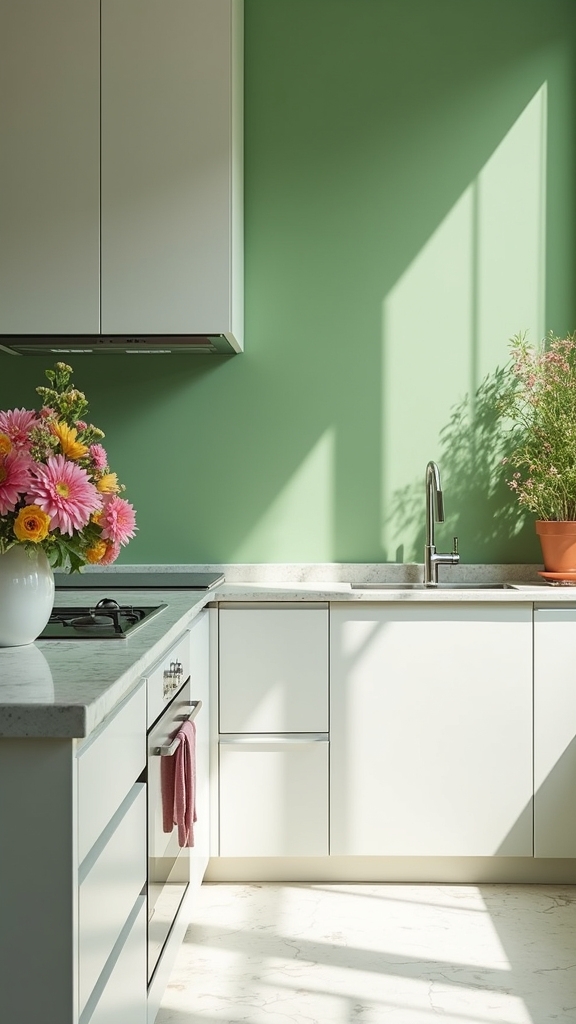
Pairing green walls with pink or yellow accents introduces a dynamic interplay of color that enlivens a white kitchen, balancing freshness with warmth. This approach leverages the invigorating qualities of green walls as a backdrop for playful pink accents or bright yellow accents. The result is a nature-inspired, playful atmosphere that integrates visual interest and emotional uplift. Decorative elements such as pastel kitchen accessories, textiles, or wall art can further enhance this vibrant scheme. Utilizing contrasting yet harmonious hues enhances the overall design, reflecting principles of color theory and spatial harmony. The table below summarizes effective pairings and their visual impact.
| Color Pairing | Design Effect |
|---|---|
| Green walls + blush pink accents | Serene, cheerful, uplifting |
| Green walls + sunny yellow accents | Energetic, warm, inviting |
| Pastel green + pink textiles | Soft, harmonious, playful |
| Deep green + bright yellow decor | Bold, dynamic, modern |
| Decorative elements integration | Cohesive, nature-inspired aesthetic |
Minimalist White and Green Spaces for a Clean Look
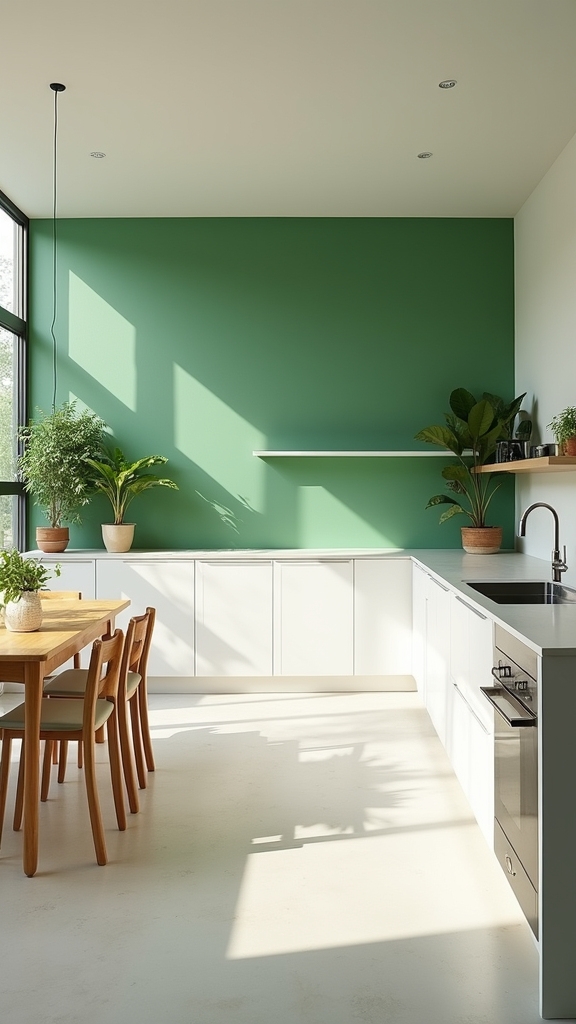
Beyond playful color combinations, a minimalist approach to white kitchens with green walls emphasizes clarity and visual restraint. This design principle capitalizes on white cabinetry and countertops to reflect natural light, enhancing spatial openness. Soft green wall tones such as sage or mint introduce a calm, nature-inspired palette, fostering serenity while maintaining freshness. The integration of organic materials and smooth matte finishes further refines the minimalist aesthetic. Greige cabinetry offers practical storage solutions, with easy maintenance and cleaning due to light-colored surfaces. Key design strategies include:
- Select white surfaces to amplify brightness and support a clean visual field.
- Use muted green walls for a subtle, calming nature-inspired accent.
- Incorporate natural wood or stone elements to harmonize textures.
- Employ botanical decor sparingly to reinforce the green theme without clutter.
This disciplined approach delivers a tranquil, contemporary kitchen environment.
Frequently Asked Questions
What Is the Best Green Color for a Kitchen?
Selecting the best green color for a kitchen depends on desired ambiance; sage green, mint green, olive green, forest green, seafoam green, and pastel green each offer distinctive visual emphasis, supporting design principles of harmony, tranquility, and contemporary sophistication in culinary spaces.
How Do You Make a White Kitchen Feel Cozy?
To make a white kitchen feel cozy, designers recommend integrating cozy textiles, warm lighting, and natural elements. Soft hues, personal touches, and an inviting layout collectively enhance visual warmth, tactile comfort, and spatial intimacy, aligning with effective interior design principles.
Which Color Combination Is Best With White for a Kitchen?
When selecting the best color combination with white for a kitchen, current kitchen trends favor accent colors like soft green or navy. Color psychology, design balance, texture contrast, and lighting effects all influence a harmonious, visually dynamic space.
What Color Goes With Green Kitchen Walls?
In contemporary kitchen decor trends, green accent colors pair well with warm wood, soft neutrals, or metallic finishes. Complementary color palettes featuring nature-inspired hues and mood-boosting shades enhance green wall textures, maximizing visual harmony and inviting ambiance.
Conclusion
In conclusion, integrating green walls into a white kitchen palette offers a sophisticated balance of serenity and vibrancy. Using tonal variations—from soft sage to bold olive—infuses visual depth while maintaining a harmonious environment. Whether through subtle accent walls, textured green tiles, or layering with natural wood and brass, these design principles enhance spatial perception and evoke a calm, nature-inspired ambiance. Ultimately, this approach raises kitchen aesthetics, embracing both timeless elegance and contemporary comfort.
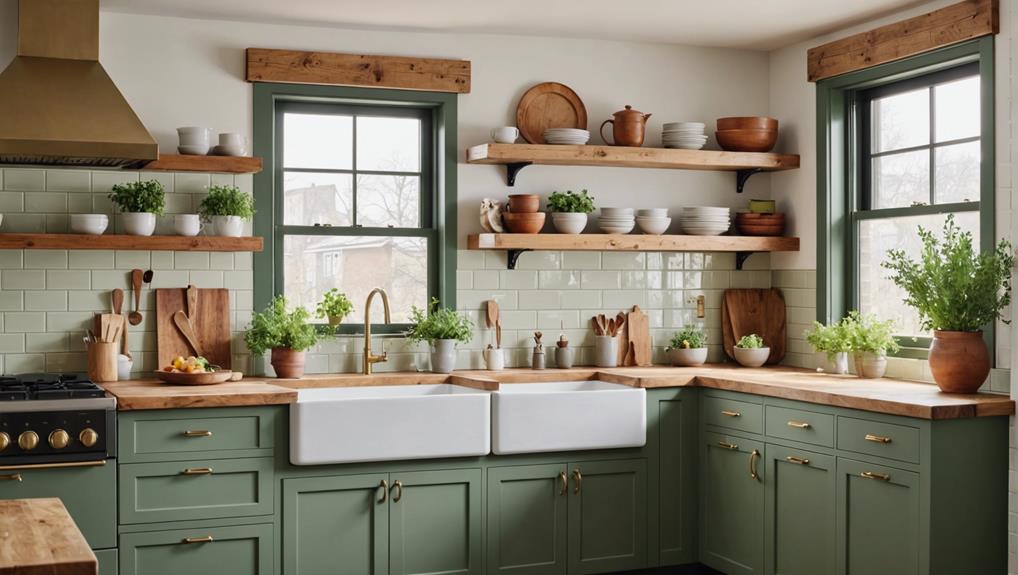
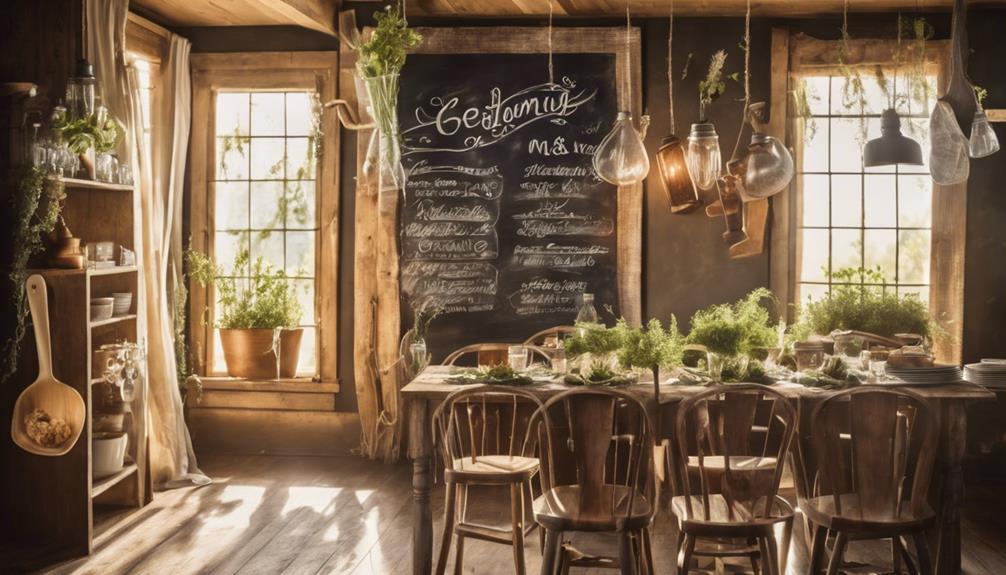
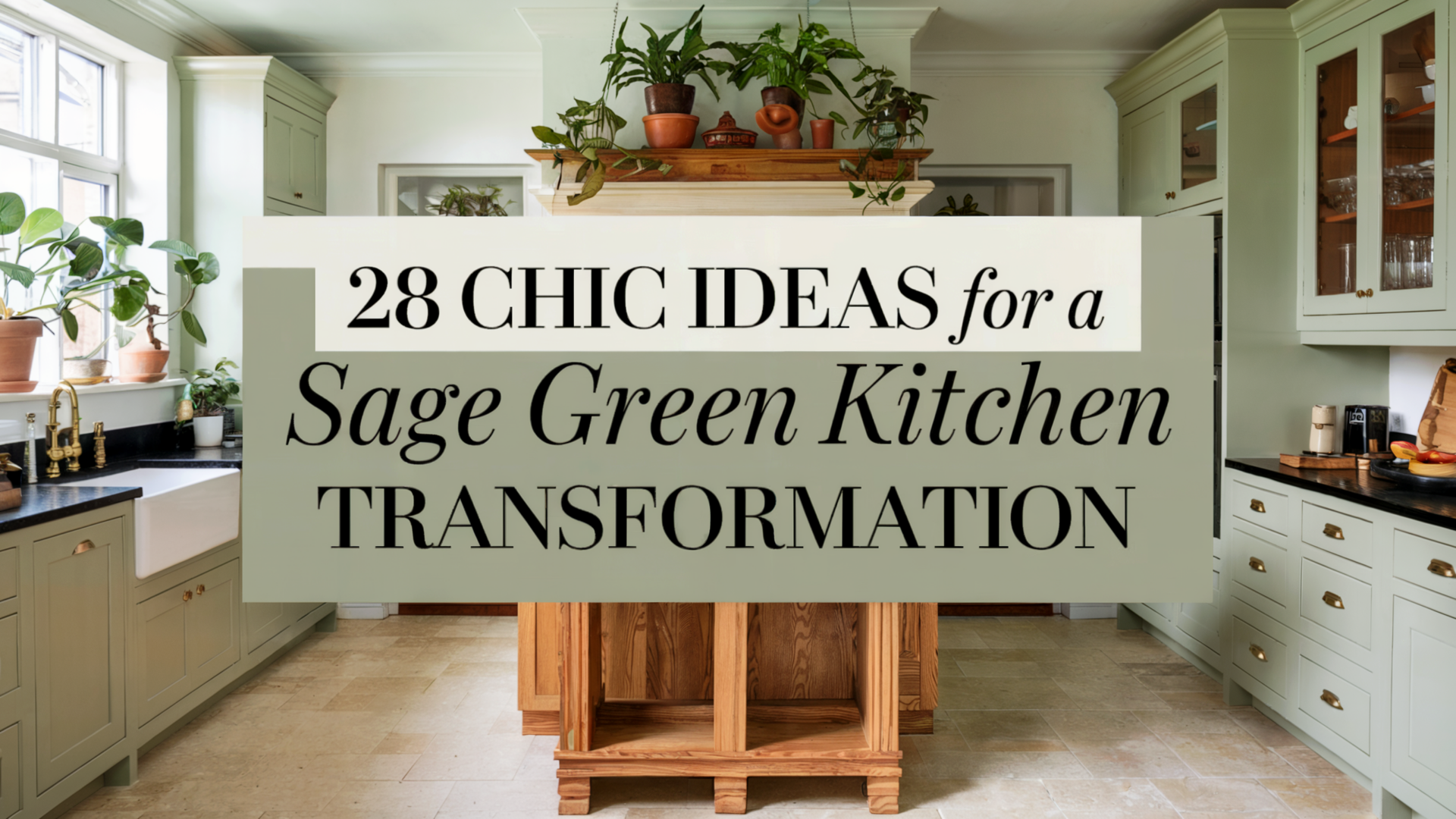
Leave a Reply